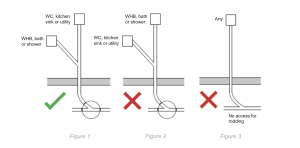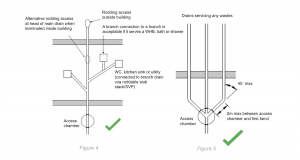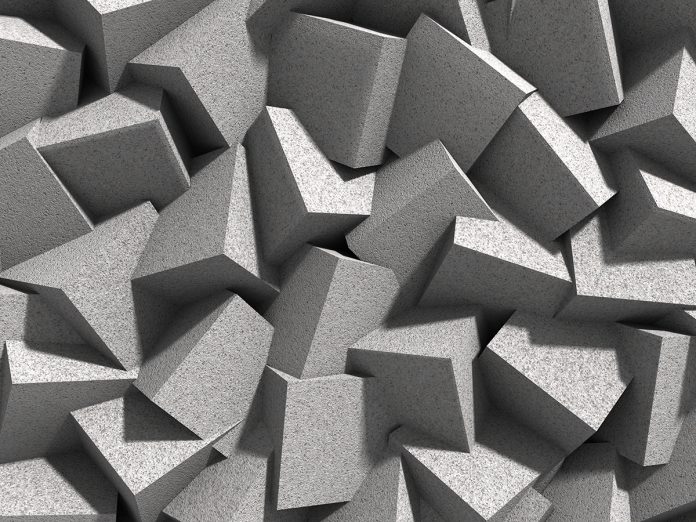This update provides additional guidance relating to how the Functional Requirements in the Technical Manual may be satisfied where Y-junctions are proposed under buildings
Drains under a building must be laid in straight runs – slight curves can be accepted, providing the length of the run can be effectively cleaned by the use of rods. Having Y-junctions under a building makes it difficult to clear any blockages; however we can accept them in some very limited circumstances.
When can Y-junctions be used?
Drains carrying heavily soiled waste (kitchen sink, WC, washing machine etc.) should not be connected via Y-junctions under a building as maintenance will be difficult (Figure 2/3). They should be in straight runs to an access point outside the building to allow the drain to be rodded. If Y-junctions are used, they should only be used in the circumstances shown below:
- Where the branch drain discharges lightly soiled waste such as a wash hand basin, shower or bath, a Y-junction may be used to connect to another drain under the building (see Figure 1).

- Branch drains formed off Y-junctions can be used where (see Figure 4):
- The main drain extends the full length of the building and external rodding access is provided at both ends of the main drain. If this is not achievable, an alternative rodding access point can be provided of the head of the main drain, which terminates inside the building.
- Branch drains carrying heavily soiled waste are provided with a roddable stub stack. This should not involve removing any sanitary fittings or boxing (so an access plate should be provided).

External access chambers can serve up to three branch drains provided the angles of the connections, bends and distance from the first bend comply with Figure 5.
Warranty position
This technical document has provided guidance on where Y-junctions can be used; if possible, they should be avoided as they makes it difficult to clear blockages. However, if they are proposed, they should only be used in the circumstances highlighted above.
Every care was taken to ensure the information in this article was correct at the time of publication.
Guidance provided does not replace the reader’s professional judgement and any construction project should comply with the relevant Building Regulations or applicable technical standards. For the most up to date Premier Guarantee technical guidance please refer to your Risk Management Surveyor and the latest version of the Premier Guarantee Technical Manual.
2 Shore Lines Building | Shore Road | Birkenhead | Wirral | CH41 1AU
T 0800 107 8446 | E info@premierguarantee.co.uk | W www.premierguarantee.com
*Please note this is a commercial profile.














